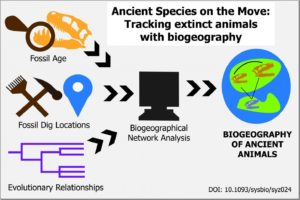by Charles the moderator, May 31, 2019 in WUWT
University of Tokyo
One researcher at the University of Tokyo is in hot pursuit of dinosaurs, tracking extinct species around ancient Earth. Identifying the movements of extinct species from millions of years ago can provide insights into ancient migration routes, interaction between species, and the movement of continents.
“If we find fossils on different continents from closely related species, then we can guess that at some point there must have been a connection between those continents,” said Tai Kubo, Ph.D., a postdoctoral researcher affiliated with the University Museum at the University of Tokyo.
A map of life – biogeography
Previous studies in biogeography — the geographic distribution of plants and animals — had not considered the evolutionary relationships between ancient species. The new method that Kubo designed, called biogeographical network analysis, converts evolutionary relationships into geographical relationships.
…

By combining data from fossils and models of the ancient Earth, researchers can map where ancient species may have migrated. This method, called biogeographical network analysis, converts evolutionary relationships between species into geographical relationships. This method was used in research by Tai Kubo, Ph.D., a postdoctoral researcher affiliated with the University Museum at the University of Tokyo. Credit Caitlin Devor, The University of Tokyo, CC-BY Usage Restrictions Image by Caitlin Devor, The University of Tokyo, CC-BY
